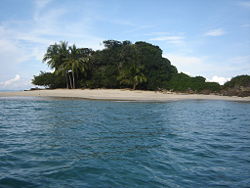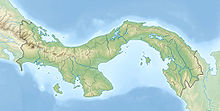- Coiba
-
Coiba National Park and its Special Zone of Marine Protection * UNESCO World Heritage Site
Isla Granito de Oro, Coiba National Park.Country Panama Type Natural Criteria ix, x Reference 1138 Region ** Latin America and the Caribbean Inscription history Inscription 2005 (29th Session) * Name as inscribed on World Heritage List
** Region as classified by UNESCOCoiba is the largest island in Central America, with an area of 503 square kilometers, off the Pacific coast of the Panamanian province of Veraguas. It is part of the Montijo District of that province.
Contents
History
Coiba separated from continental Panama about 12,000 to 18,000 years ago when sea levels rose. Plants and animals on the new island became isolated from mainland populations and over the millennia most animals have diverged in appearance and behavior from their mainland counterparts. The island is home to many endemic subspecies, including the Coiba Island Howler monkey, the Coiba Agouti and the Coiba Spinetail.
Coiba was home to the Coiba Cacique Indians until about 1560, when they were conquered by the Spanish and forced into slavery. In 1919 a penal colony was built on the island and during the years that Panama was under the dictatorships of Omar Torrijos and Manuel Noriega, the prison on Coiba was a feared place with a reputation for brutal conditions, extreme tortures, executions and political murder. Nobody knows exactly how many people were killed in the prison during this period, but sources claim that the number could be close to three hundred. As such, the island was avoided by locals, and other than the prison, was completely undeveloped.
After the prison was closed down in 2004, its pristine condition made it ideal as a reserve. It is one of the last places in Central America the Scarlet Macaw can be found in large numbers in the wild. The island is about 75% forested with a large fraction standing as ancient forest. Coiba Island is home to rare plant species found only on the island. As well, the island harbors tree species that have long disappeared from the mainland due to deforestation and overharvesting.
The island was declared a National Park in 1992 and in July 2005, Unesco declared the entire Coiba National Park a "World Heritage Site".
Environment
Coiba's underwater topography is linked by the underwater Cordillera mountain chain to Coco's and the Galapagos Islands. Scientists from the Smithsonian Tropical Research Institute have proclaimed it an unparalleled destination for discovering new species. Rachel Collin, a Smithsonian project coordinator said: "It's hard to imagine, while snorkeling around a tropical island that's so close to the United States, that half the animals you see are unknown to science.”[1]
Its unique location protects it from the damaging winds and other effects of El Niño, allowing it to sustain the uninterrupted evolution of new marine species including whale and tiger sharks, sperm whales, sea turtles, angel rays and giant schools of fish. It is also the last refuge for a number of threatened terrestrial animals such as the crested eagle and several sub-species of agouti, possum and howler monkey (including a Coiba Island Howler Monkey).
The waters adjacent to the island are teeming with marine life. It is surrounded by one of the largest coral reefs on the Pacific Coast of the Americas. The Indo-Pacific current through the Gulf of Chiriqui provides a unique dive environment. The warm current brings with it coral and many of the pacific tropical underwater life that you would not expect on the Pacific Coast of the Americas. Also with it come the larger fish/mammals such as humpback whales, sharks, whale sharks, orcas and more.
References
- ^ "45 New Reasons to Conserve Panama’s Coiba National Park". Smithsonian Tropical Research Institute. http://www.stri.org/. Retrieved 17 March 2011.]
External links
Coordinates: 7°25′58.80″N 81°45′57.60″W / 7.433°N 81.766°W
Categories:- Pacific islands of Panama
- World Heritage Sites in Panama
Wikimedia Foundation. 2010.


